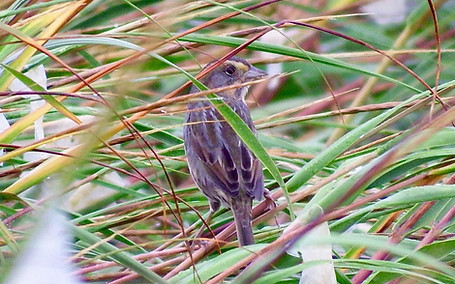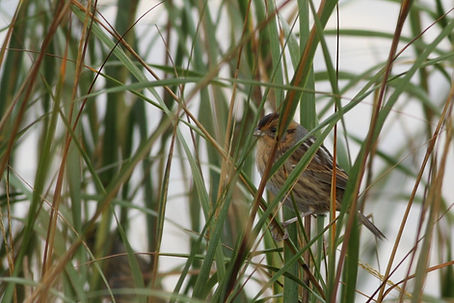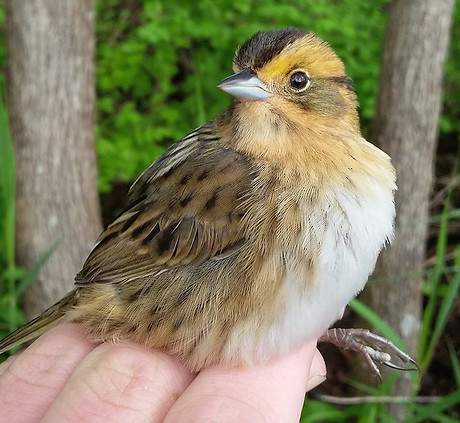Salt Marsh Life
Nelson's Sparrows (Ammospiza maritima)
at Jacob’s Point
- by Joel Eckerson

Nelson’s Sparrow (Ammospiza maritima) is a close relatives of our study species, the Saltmarsh Sparrow (Ammospiza caudacuta). The two species are similar in both plumage and song. In fact, they were considered the same species until 1995. Since then, a large amount of data has been collected about the two species. With that research, many articles and field guides have made distinguishing the differences between the two species a bit easier.
While Saltmarsh Sparrows breed solely in salt marshes on the Atlantic coast, Nelson's Sparrows have one population (Ammospiza nelsoni nelsoni) that breeds in grassy freshwater marshes in northern midwestern North America, and another population (Ammospiza nelsoni subvirgata) that breeds on the same habitat as Saltmarsh Sparrows––in salt marshes from northeastern Massachusetts north to the Gulf of St. Lawrence.
These two populations of Nelson’s Sparrows have been designated as two different subspecies (ssp). Identifying the difference between the Interior and Atlantic subspecies in the field is where birding gets even harder than it already is.
The differences: The Interior (Ammospiza nelsoni subvirgata) subspecies (ssp.) has white fringes on the upper back, while the Atlantic ssp. (Ammospiza nelsoni nelsoni) has gray fringes. The Interior ssp. has a bright orange face and breast, while the face of the Atlantic ssp. is duller orange with a faint grayish tinge overall. The Interior ssp. has thin brown streaks on the breast and sides, while the Atlantic ssp. has broader gray streaks on the breast and sides. And finally, the Interior ssp. has a smaller beak than the Atlantic ssp.
These two subspecies look so similar that it takes great views and/or pictures to tell them apart.

Nelson's Sparrow (Atlantic) - Key ID points are Grayish tinge overall and Gray fringes on the back. Photo by: ©Deirdre Robinson, taken at Jacobs Point
There have been a total of ten Nelson’s Sparrow sightings at Jacobs Point since May of 2017. Eight of those sightings were made during the expected time, mid- to late- fall, when they were migrating south to their wintering grounds. Out of all the sightings in the fall, one happened to be an Interior subspecies while the rest were Atlantic.

Nelson's Sparrow(Interior) - Photo taken on October 11th at Colt State Park by: ©Evan Lipton. Bright orange face, brown streaking on breast and sides, with bright white braces are all field marks that point toward Interior ssp.)
The Interior is more uncommon since only a fraction of their population migrates down the Atlantic coast. The Atlantic subspecies is more common, since their entire population migrates down the Atlantic coast.
The strangest and rarest of all the Nelson’s Sparrow sightings at Jacobs Point are the two spring records. The first was on May 7th, 2017. Our team caught it, while setting mist nets for Saltmarsh Sparrows.
This individual was confirmed to be an Atlantic subspecies.

Color brightest in the lores, brown streaking on the sides, and sometimes white fringing on the back are several field marks that are displayed by breeding plumage Atlantic ssp. They will appear grayer in their non breeding plumage. Photo by: ©Evan Lipton
It was most likely migrating to its breeding grounds somewhere NE of Massachusetts. This was an uncommon sighting since Nelson’s Sparrows usually go undetected while migrating.
The second spring record was on June 2nd of this year.

Probable Atlantic Subspecies Nelson's Sparrow seen at Jacobs Point this spring. Photo by: ©Joel Eckerson.
I happened to discover this bird along the main creek that enters the Jacobs Point salt marsh. First by song, then by several distant looks of the front of the bird. Sadly, I could never get positive confirmation of which subspecies it was. The color appears to be brightest in the lores (while the color would be brightest on the supercilium on the Interior ssp.) when looking at the photos and overall duller face makes me lean toward Atlantic ssp. But because I’m not 100% sure, I will identify it as a Nelson’s Sparrow.
This record of Nelson’s Sparrow was Rhode Island's first-ever June record! My guess is that this bird was a very late migrant, that happened to stop at Jacobs Point for a day (to rest and refuel).
.....
Please note: Jacob's Point is owned and managed by the Warren Land Conservation Trust (WLCT). Except with WCLT permission, access to Jacob's Point is limited to the foot path only; it leads from the East Bay Bike Path to the Warren River. Only the Saltmarsh Sparrow Research Initiative (SSRI) has been granted access to the salt marsh. Thank you for protecting this fragile habitat.
.....
For more information, visit the Nelson's Sparrow resource on All About Birds from the Cornell Lab of Ornithology
Joel Eckerson is the 2020 Intern at Jacob's Point and a key member of the Saltmarsh Sparrow Research Initiative team.
